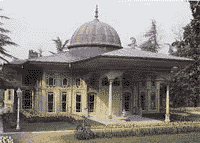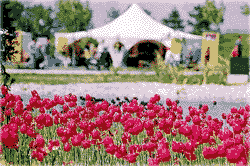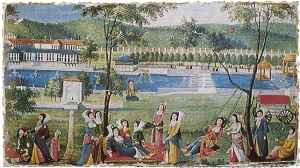Cappadocia
Hotels
Guide
Book
Cappadocian
Sites
Flora
and Fauna
Nature
Cappadocia
Photographic
Tour
History
of Cappadocia
Entertainment |

Let us have fun,
let us all dance and play,
for it is tulip time!
Paeans to the tulip resounded in the air. In İstanbul,
in the early 18th century, the Sultan and the populace
rejoiced in music, festivities, parades and dances. Countless tulips
of all varieties with such poetic names as Blue Pearl, Light
of Dawn, Ruby Drop and The Divine Throne adorned
the Ottoman imperial capital. It was a period of peace, lavish
entertainment and creativity. An early 20th century
historian gave it the name of The Tulip Age. This perfect
name will endure, because it encapsulates the spirit of a halcyon
epoch of about twelve years during which the tulip was the symbol of
the sensuality of the creative arts... and the joy of life as an
art.
|
| In the reign of Sultan Ahmed
III, following more than four centuries of war, conquest
and defeat, the Ottomans suddenly decided to enjoy la dolce vita.
The ruling establishment turned away from military engagement and
diplomacy to wallow in wine, women and song. Carpe diem: Seize the
day. All they wanted was to create Paradise on Earth - the pleasure
Principle became their doctrine. The French Ambassador, de
Villeneuve, reported that the Turkish Court seemed perpetually
bent upon some new excursion, continually filing by in gorgeous
cavalcades or floating upon the waves of the Bosphorus or the Golden
Horn. In eight months, after repeated requests, he was able to
see the Grand Vizier once - and the famous Grand Vizier Damat İbrahim
Paşa from Nevşehir talked to him only about tulips.
Tulips were ubiquitous - not only in
the gardens of the Topkapı Palace and of wealthy people, but also
in the backyards and window-sills of the houses where the poor
lived. Artists glorified this time-honoured Turkish flower on tiles,
fabrics, embroideries, miniature paintings, book illuminations,
head-dress and slippers, rowboats and tombstones, painted glass and
household utensils. As a leitmotif, it enlivened all the creative
genres.
The tulip, indigenous to parts of
Central Asia Minor where the Turks had already held sway for many
centuries, stood as the premier flower of the Ottomans. It even
acquired a religious significance because, in the Arabic script that
the Ottoman used, the name of the tulip, lâle, bears a
resemblance to Allah. The etymology of the word tulip,
however, may be traced to dulband, or turban, which European
and British travellers likened to the shape of the flowers.
|
 This
Turkish flower was already cherished in Ottoman gardens,
visual arts, and classical poetry by the time Sultan Süleyman the
Magnificent ascended the throne in 1520. His supreme judge, perhaps
the greatest legal mind of Ottoman Islam, Ebussuud Efendi had a
passion for flowers, especially for tulips. In 1554, Ambassador Busbecq
came to the court of Süleyman the Magnificent as the envoy of
Austrian Emperor and was struck by the varieties and the vibrancy of
flowers in the Ottoman imperial capital. He wrote: This
Turkish flower was already cherished in Ottoman gardens,
visual arts, and classical poetry by the time Sultan Süleyman the
Magnificent ascended the throne in 1520. His supreme judge, perhaps
the greatest legal mind of Ottoman Islam, Ebussuud Efendi had a
passion for flowers, especially for tulips. In 1554, Ambassador Busbecq
came to the court of Süleyman the Magnificent as the envoy of
Austrian Emperor and was struck by the varieties and the vibrancy of
flowers in the Ottoman imperial capital. He wrote:
We saw everywhere an abundance
of flowers... The Turks are so fond of flowers that even the
marching troops have their orders not to trample on them.
|
| Busbecq was especially astonished to
see the tulip, a flower unknown to Europeans. He took some bulbs
with him back to Vienna where, in 1559, the Swiss botanist Konrad
Gesner saw garden tulips for the first time, and the first
picture of the tulip, which he described as a big reddish flower
similar to a red lily, appeared in his Book of Garden Flowers
in 1561. Later the celebrated Dutch botanist Clusius
obtained a number of bulbs from Busbecq, developed many new
varieties - and in a few decades, tulips had triumphantly fired the
European imagination. In the 1630, a craze often referred to as Tulipomania
swept through Holland. Vagaries of the tulip trade resulted in vast
fortunes made or lost. Yet, the aesthetic experience of tulips has
endured in Holland for more than 350 years now.
The Tulip Ottomania erupted as
the second decade of the 18th century drew to a close.
Ottomans were breeding their own varieties and importing dozens more
from Holland and elsewhere. By the mid 1720s they had close to 900
varieties each bearing a special name. A later document states that
there were as many as 1.750 varieties. Some were sold for 1.000 gold
pieces each. When a foreign ambassador brought but lost a special
new breed intended as a gift for the Sultan, town criers strolled
through İstanbul streets offering a huge reward, a fortune, to
finder. It was never found or never turned in.
But the creative spirit as well as
the excesses of the Age dwarfed the tulip fields. Festivals were
held lasting the proverbial 40 days and 40 nights. İstanbul, the
ancient city that already boasted of 25 centuries of sovereign
history, kept vibrating with the sounds, sights and pleasures of the
revelries organized for its wealthy residents and sometimes for the
entire populace. A chronicler reports that 1.500 cooks prepared for
100.000 people a day sumptuous food made of 16.000 chickens, geese
and turkeys and 15000 cauldrons of meat pilav were consumed.
At night 15 to 25 thousand lanterns
illuminated the city and 5000 to 7000 firecrackers decked the skies.
Music, dance, mock battles, comedy, acrobatics, magic shows, javelin
games, torch pageants- an inexhaustible diversity of entertainment.
During the day, parades with
fascinating floats and displays went through the ancient hippodrome
and some of the main avenues. Guilds of artisans, one after another
presented their works and wares. The whole city was enchanted.
The spirit of the age revelled in new
lilting compositions, in miniature paintings (particularly those by
the greatest stylist Levni), in dazzling decorative arts, in erotic
and hedonistic poetry, especially the cheerful verses of Nedim
(who rhapsodised: Lets laugh and play, lets enjoy the
world to the hilt.)
|
|
 In
about twelve years, the Tulip Age gave new direction and brave new
dimensions to many Ottoman arts. This was also the period which
intensified relations with Europe. İstanbul witnessed the emergence
of European architectural styles-and Ottoman influence would lead to
the European fad that came to be known as Turquerie. The
Tulip Age also ushered in the printing press for the publication of
books in the Turkish language. Impetus was given to science,
libraries, translation, and intellectual exploration. In
about twelve years, the Tulip Age gave new direction and brave new
dimensions to many Ottoman arts. This was also the period which
intensified relations with Europe. İstanbul witnessed the emergence
of European architectural styles-and Ottoman influence would lead to
the European fad that came to be known as Turquerie. The
Tulip Age also ushered in the printing press for the publication of
books in the Turkish language. Impetus was given to science,
libraries, translation, and intellectual exploration.
|
All the merriment in the world could
not distract the poverty-stricken people. Too much circus and not
enough bread led to a plebeian uprising, and the Sultan was toppled.
In 1730 the Tulip Age came to an abrupt end. But the glory of its
arts endures - and the love for tulips.
- Source:
- By Prof.
Talat S. Halman
SKYLIFE 4/92
|
|

